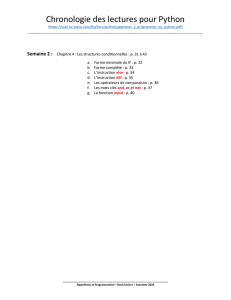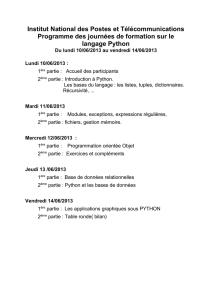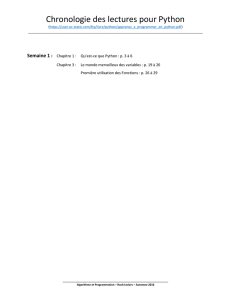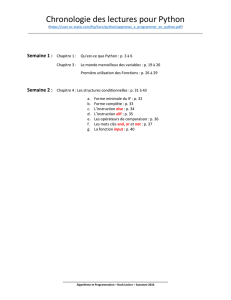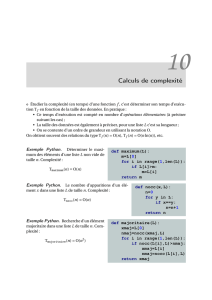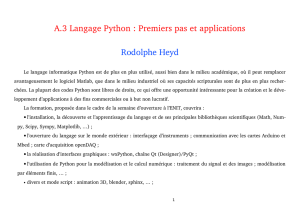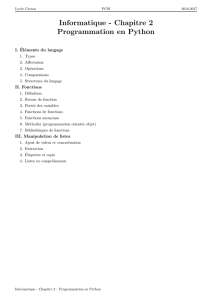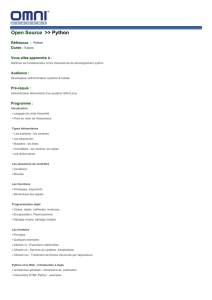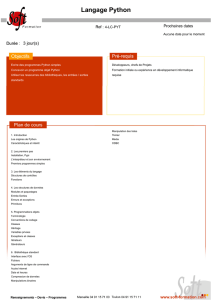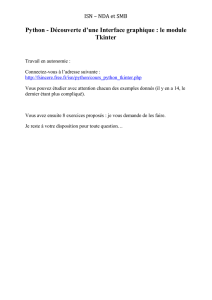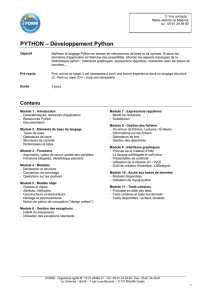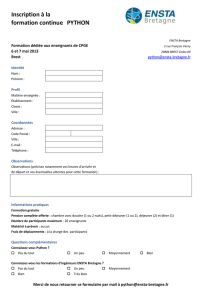Python Montréal 29 nov 2010 -- Sage
publicité
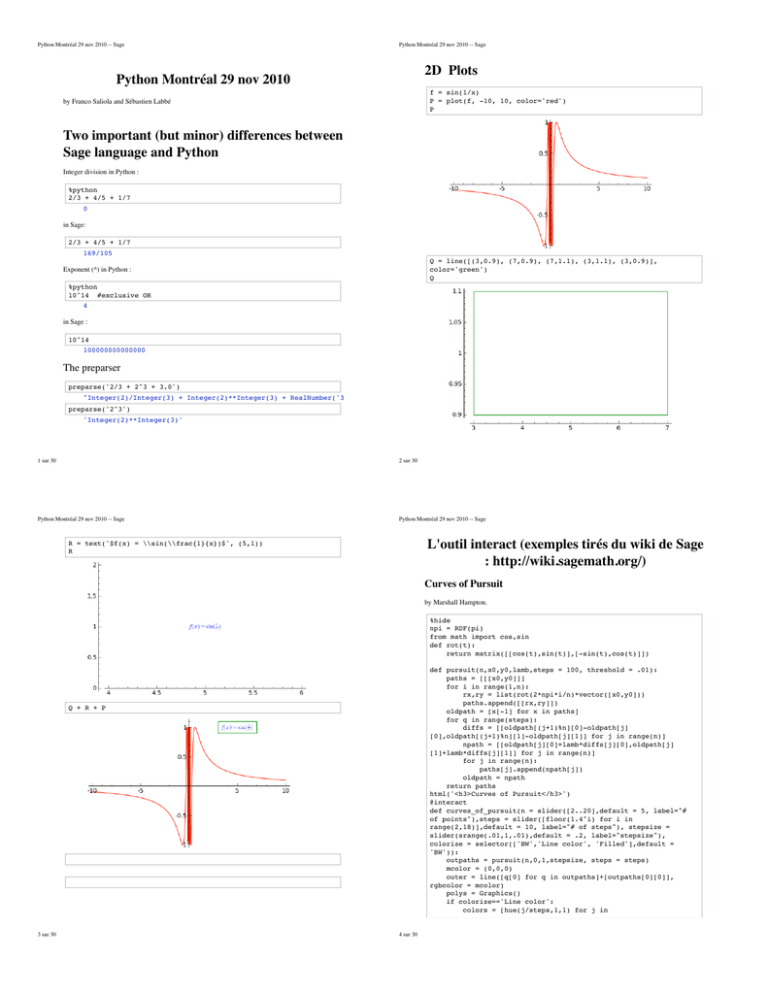
Python Montréal 29 nov 2010 -- Sage
Python Montréal 29 nov 2010 -- Sage
2D Plots
Python Montréal 29 nov 2010
f = sin(1/x)
P = plot(f, -10, 10, color='red')
P
by Franco Saliola and Sébastien Labbé
Two important (but minor) differences between
Sage language and Python
Integer division in Python :
%python
2/3 + 4/5 + 1/7
0
in Sage:
2/3 + 4/5 + 1/7
169/105
Q = line([(3,0.9), (7,0.9), (7,1.1), (3,1.1), (3,0.9)],
color='green')
Q
Exponent (^) in Python :
%python
10^14 #exclusive OR
4
in Sage :
10^14
100000000000000
The preparser
preparse('2/3 + 2^3 + 3.0')
"Integer(2)/Integer(3) + Integer(2)**Integer(3) + RealNumber('3.0')"
preparse('2^3')
'Integer(2)**Integer(3)'
1 sur 30
2 sur 30
Python Montréal 29 nov 2010 -- Sage
Python Montréal 29 nov 2010 -- Sage
L'outil interact (exemples tirés du wiki de Sage
: http://wiki.sagemath.org/)
R = text('$f(x) = \\sin(\\frac{1}{x})$', (5,1))
R
Curves of Pursuit
by Marshall Hampton.
%hide
npi = RDF(pi)
from math import cos,sin
def rot(t):
return matrix([[cos(t),sin(t)],[-sin(t),cos(t)]])
def pursuit(n,x0,y0,lamb,steps = 100, threshold = .01):
paths = [[[x0,y0]]]
for i in range(1,n):
rx,ry = list(rot(2*npi*i/n)*vector([x0,y0]))
paths.append([[rx,ry]])
oldpath = [x[-1] for x in paths]
for q in range(steps):
diffs = [[oldpath[(j+1)%n][0]-oldpath[j]
[0],oldpath[(j+1)%n][1]-oldpath[j][1]] for j in range(n)]
npath = [[oldpath[j][0]+lamb*diffs[j][0],oldpath[j]
[1]+lamb*diffs[j][1]] for j in range(n)]
for j in range(n):
paths[j].append(npath[j])
oldpath = npath
return paths
html('<h3>Curves of Pursuit</h3>')
@interact
def curves_of_pursuit(n = slider([2..20],default = 5, label="#
of points"),steps = slider([floor(1.4^i) for i in
range(2,18)],default = 10, label="# of steps"), stepsize =
slider(srange(.01,1,.01),default = .2, label="stepsize"),
colorize = selector(['BW','Line color', 'Filled'],default =
'BW')):
outpaths = pursuit(n,0,1,stepsize, steps = steps)
mcolor = (0,0,0)
outer = line([q[0] for q in outpaths]+[outpaths[0][0]],
rgbcolor = mcolor)
polys = Graphics()
if colorize=='Line color':
colors = [hue(j/steps,1,1) for j in
Q + R + P
3 sur 30
4 sur 30
Python Montréal 29 nov 2010 -- Sage
Python Montréal 29 nov 2010 -- Sage
range(len(outpaths[0]))]
elif colorize == 'BW':
colors = [(0,0,0) for j in range(len(outpaths[0]))]
else:
colors = [hue(j/steps,1,1) for j in
range(len(outpaths[0]))]
polys = sum([polygon([outpaths[(i+1)%n]
[j+1],outpaths[(i+1)%n][j], outpaths[i][j+1]], rgbcolor =
colors[j]) for i in range(n) for j in range(len(outpaths[0])-1)])
#polys = polys[0]
colors = [(0,0,0) for j in range(len(outpaths[0]))]
nested = sum([line([q[j] for q in outpaths]+
[outpaths[0][j]], rgbcolor = colors[j]) for j in
range(len(outpaths[0]))])
lpaths = [line(x, rgbcolor = mcolor) for x in outpaths]
show(sum(lpaths)+nested+polys, axes = False, figsize =
[5,5], xmin = -1, xmax = 1, ymin = -1, ymax =1)
Curves of Pursuit
# of points
5
# of steps
10
stepsize
0.200000000000000
BW
colorize
Factor Trees
by William Stein
%hide
import random
def ftree(rows, v, i, F):
if len(v) > 0: # add a row to g at the ith level.
rows.append(v)
5 sur 30
6 sur 30
Python Montréal 29 nov 2010 -- Sage
Python Montréal 29 nov 2010 -- Sage
w = []
for i in range(len(v)):
k, _, _ = v[i]
if k is None or is_prime(k):
w.append((None,None,None))
else:
d = random.choice(divisors(k)[1:-1])
w.append((d,k,i))
e = k//d
if e == 1:
w.append((None,None))
else:
w.append((e,k,i))
if len(w) > len(v):
ftree(rows, w, i+1, F)
def draw_ftree(rows,font):
g = Graphics()
for i in range(len(rows)):
cur = rows[i]
for j in range(len(cur)):
e, f, k = cur[j]
if not e is None:
if is_prime(e):
c = (1,0,0)
else:
c = (0,0,.4)
g += text(str(e), (j*2-len(cur),-i),
fontsize=font, rgbcolor=c)
if not k is None and not f is None:
g += line([(j*2-len(cur),-i),
((k*2)-len(rows[i-1]),-i+1)],
alpha=0.5)
return g
n 100
font
redraw
Illustrating the prime number theorem
by William Stein
@interact
def factor_tree(n=100, font=(10, (8..20)), redraw=['Redraw']):
n = Integer(n)
rows = []
v = [(n,None,0)]
ftree(rows, v, 0, factor(n))
show(draw_ftree(rows, font), axes=False)
7 sur 30
10
Redraw
@interact
def _(N=(100,(2..2000))):
html("<font color='red'>$\pi(x)$</font> and <font
color='blue'>$x/(\log(x)-1)$</font> for $x < %s$"%N)
show(plot(prime_pi, 0, N, rgbcolor='red') +
plot(x/(log(x)-1), 5, N, rgbcolor='blue'))
8 sur 30
Python Montréal 29 nov 2010 -- Sage
N
Python Montréal 29 nov 2010 -- Sage
def __init__(self, symbol):
self.symbol = symbol.upper()
98
def __repr__(self):
return "%s (%s)"%(self.symbol, self.yahoo()['price'])
!(x) and x=(log(x) ! 1) for x < 282
def yahoo(self):
url = 'http://finance.yahoo.com/d/quotes.csv?s=%s&f=%s'
% (self.symbol, 'l1c1va2xj1b4j4dyekjm3m4rr5p5p6s7')
values =
urllib.urlopen(url).read().strip().strip('"').split(',')
data = {}
data['price'] = values[0]
data['change'] = values[1]
data['volume'] = values[2]
data['avg_daily_volume'] = values[3]
data['stock_exchange'] = values[4]
data['market_cap'] = values[5]
data['book_value'] = values[6]
data['ebitda'] = values[7]
data['dividend_per_share'] = values[8]
data['dividend_yield'] = values[9]
data['earnings_per_share'] = values[10]
data['52_week_high'] = values[11]
data['52_week_low'] = values[12]
data['50day_moving_avg'] = values[13]
data['200day_moving_avg'] = values[14]
data['price_earnings_ratio'] = values[15]
data['price_earnings_growth_ratio'] = values[16]
data['price_sales_ratio'] = values[17]
data['price_book_ratio'] = values[18]
data['short_ratio'] = values[19]
return data
Stock Market data, fetched from Yahoo and Google
by William Stein
%hide
import urllib
class Day:
def __init__(self, date, open, high, low, close, volume):
self.date = date
self.open=float(open); self.high=float(high);
self.low=float(low); self.close=float(close)
self.volume=int(volume)
def __repr__(self):
return '%10s %4.2f %4.2f %4.2f %4.2f %10d'%(self.date,
self.open, self.high,
self.low, self.close, self.volume)
def historical(self):
try:
return self.__historical
except AttributeError:
pass
symbol = self.symbol
def get_data(exchange):
name = get_remote_file('http://finance.google.com
/finance/historical?q=%s:%s&output=csv'%(exchange,
symbol.upper()),
verbose=False)
class Stock:
9 sur 30
10 sur 30
Python Montréal 29 nov 2010 -- Sage
Python Montréal 29 nov 2010 -- Sage
return open(name).read()
R = get_data('NASDAQ')
if "Bad Request" in R:
R = get_data("NYSE")
R = R.splitlines()
headings = R[0].split(',')
self.__historical = []
try:
for x in reversed(R[1:]):
date, opn, high, low, close, volume =
x.split(',')
self.__historical.append(Day(date,
opn,high,low,close,volume))
except ValueError:
pass
self.__historical =
Sequence(self.__historical,cr=True,universe=lambda x:x)
return self.__historical
diff.append((i, (z1.high+z1.low)/2 - (z0.high +
z0.low)/2))
P = line(diff,thickness=0.5) + points(diff,
rgbcolor='black', pointsize=4) + \
text(self.symbol, (len(d)*1.05, 0),
horizontal_alignment='right', rgbcolor='black')
P.xmax(260)
return P
symbols = ['bsc', 'vmw', 'sbux', 'aapl', 'amzn', 'goog', 'wfmi',
'msft', 'yhoo', 'ebay', 'java', 'rht', ]; symbols.sort()
stocks = dict([(s,Stock(s)) for s in symbols])
@interact
def data(symbol = symbols, other_symbol='', spline_samples=
(8,[0..15])):
if other_symbol != '':
symbol = other_symbol
S = Stock(symbol)
html('<h1 align=center><font color="darkred">%s</font>
</h1>'%S)
S.plot_average(spline_samples).save('avg.png', figsize=
[10,2])
S.plot_diff().save('diff.png', figsize=[10,2])
def plot_average(self, spline_samples=10):
d = self.historical()
if len(d) == 0:
return text('no historical data at Google Finance
about %s'%self.symbol, (0,3))
avg = list(enumerate([(z.high+z.low)/2 for z in d]))
P = line(avg) + points(avg, rgbcolor='black',
pointsize=4) + \
text(self.symbol, (len(d)*1.05, d[-1].low),
horizontal_alignment='right', rgbcolor='black')
if spline_samples > 0:
k = 250//spline_samples
spl = spline([avg[i*k] for i in range(len(d)//k)] +
[avg[-1]])
P += plot(spl, (0,len(d)+30), color=(0.7,0.7,0.7))
P.xmax(260)
return P
Y = S.yahoo()
k = Y.keys(); k.sort()
html('Price during last 52 weeks:<br>Grey line is a spline
through %s points (do not take seriously!):<br> <img
src="cell://avg.png">'%spline_samples)
html('Difference from previous day:<br> <img
src="cell://diff.png">')
html('<table align=center>' + '\n'.join('<tr><td>%s</td>
<td>%s</td></tr>'%(k[i], Y[k[i]]) for i in range(len(k))) +
'</table>')
def plot_diff(self):
d = self.historical()
if len(d) == 0:
return text('no historical data at Google Finance
about %s'%self.symbol, (0,3))
diff = []
for i in range(1, len(d)):
z1 = d[i]; z0 = d[i-1]
11 sur 30
12 sur 30
Python Montréal 29 nov 2010 -- Sage
symbol
Python Montréal 29 nov 2010 -- Sage
Cryptography
aapl
The Diffie-Hellman Key Exchange Protocol
other_symbol
spline_samples
8
by Timothy Clemans and William Stein
AAPL (312.06)
@interact
def diffie_hellman(bits=slider(8, 513, 4, 8, 'Number of bits',
False),
button=selector(["Show new example"],label='',buttons=True)):
maxp = 2 ^ bits
p = random_prime(maxp)
k = GF(p)
if bits > 100:
g = k(2)
else:
g = k.multiplicative_generator()
a = ZZ.random_element(10, maxp)
b = ZZ.random_element(10, maxp)
Price during last 52 weeks:
Grey line is a spline through 8 points (do not take seriously!):
print """
<html>
<style>
.gamodp, .gbmodp {
color:#000;
padding:5px
}
.gamodp {
background:#846FD8
}
.gbmodp {
background:#FFFC73
}
.dhsame {
color:#000;
font-weight:bold
}
</style>
<h2 style="color:#000;font-family:Arial, Helvetica,
sans-serif">%s-Bit Diffie-Hellman Key Exchange</h2>
<ol style="color:#000;font-family:Arial, Helvetica, sans-serif">
<li>Alice and Bob agree to use the prime number p = %s and base
g = %s.</li>
<li>Alice chooses the secret integer a = %s, then sends Bob
Difference from previous day:
200day_moving_avg
50day_moving_avg
52_week_high
52_week_low
avg_daily_volume
book_value
change
dividend_per_share
dividend_yield
earnings_per_share
ebitda
market_cap
price
price_book_ratio
price_earnings_growth_ratio
price_earnings_ratio
price_sales_ratio
short_ratio
stock_exchange
13 sur 30
272.838
309.407
321.30
188.68
18913800
52.175
-4.81
0.00
N/A
15.154
19.364B
286.3B
312.06
6.07
0.83
20.91
4.46
0.50
"NasdaqNM"
Python Montréal 29 nov 2010 -- Sage
14 sur 30
Python Montréal 29 nov 2010 -- Sage
(<span class="gamodp">g<sup>a</sup> mod p</span>):
<br/>%s<sup>%s</sup> mod %s = <span class="gamodp">%s</span>.
</li>
<li>Bob chooses the secret integer b=%s, then sends Alice (<span
class="gbmodp">g<sup>b</sup> mod p</span>):<br/>%s<sup>%s</sup>
mod %s = <span class="gbmodp">%s</span>.</li>
<li>Alice computes (<span class="gbmodp">g<sup>b</sup> mod
p</span>)<sup>a</sup> mod p:<br/>%s<sup>%s</sup> mod %s = <span
class="dhsame">%s</span>.</li>
<li>Bob computes (<span class="gamodp">g<sup>a</sup> mod
p</span>)<sup>b</sup> mod p:<br/>%s<sup>%s</sup> mod %s = <span
class="dhsame">%s</span>.</li>
</ol></html>
""" % (bits, p, g, a, g, a, p, (g^a), b, g, b, p, (g^b),
(g^b), a, p,
(g^ b)^a, g^a, b, p, (g^a)^b)
Number of bits
Show new example
8-Bit Diffie-Hellman Key Exchange
1. Alice and Bob agree to use the prime number p = 23 and base g = 5.
a
2. Alice chooses the secret integer a = 223, then sends Bob ( g mod p ):
223
5
mod 23 = 10 .
b
3. Bob chooses the secret integer b=220, then sends Alice ( g mod p ):
220
5
mod 23 = 1 .
b
a
4. Alice computes ( g mod p ) mod p:
223
1
mod 23 = 1.
a
b
5. Bob computes ( g mod p ) mod p:
220
10
mod 23 = 1.
Dessiner une fonction !2 7! ! : la commande plot3d
def f(x, y):
return x^2 + y^2
plot3d(f, (-10,10), (-10,10), viewer='tachyon')
15 sur 30
16 sur 30
Python Montréal 29 nov 2010 -- Sage
Python Montréal 29 nov 2010 -- Sage
La commande complex_plot pour les fonctions
! 7! !
f(x) = x^4 - 1
complex_plot(f, (-2,2), (-2,2))
def newton(f, z, precision=0.001) :
while abs(f(x=z)) >= precision:
z = z - f(x=z) / diff(f)(x=z)
return z
Animations
a = animate([sin(x + float(k)) for k in srange(0,2*pi,0.3)],
xmin=0, xmax=2*pi, figsize=[2,1])
complex_plot(lambda z : newton(f, z), (-1,1), (-1,1))
a.show()
17 sur 30
18 sur 30
Python Montréal 29 nov 2010 -- Sage
Python Montréal 29 nov 2010 -- Sage
Vous pouvez rééditer n'importe quelle cellule en cliquant dessus (ou en utilisant les flèches du
clavier). Retournez plus haut et changez votre 2 + 2 en un 3 + 3 et réévaluez la cellule.
Vous pouvez aussi éditer ce texte-ci en double cliquant dessus ce qui fera apparaître un éditeur de
texte TinyMCE Javascript. Vous pouvez même ajouter des expressions mathématiques telles que
sin(x) ! y 3 comme avec LaTeX.
Z
ex dx = ex + c
Comment consulter l'aide contextuelle et
obtenir de la documentation
Vous trouvez la liste des fonctions que vous pouvez appelez sur un objet X en tappant X.<touche de
tabulation>.
Utilisation du Notebook : Écriture, édition et
évaluation d'une saisie
X = 2009
Pour évaluer une saisie dans le Notebook de Sage, tapez la saisie dans une cellule et faites shiftentrée ou cliquer le lien evaluate. Essayez-le maintenant avec une expression simple (e.g., 2 + 2).
La première évaluation d'une cellule prend plus de temps que les fois suivantes, car un processus
commence.
Écrivez X. et appuyez sur la touche de tabulation.
X.factor()
7^2 * 41
2+3
5
Une fois que vous avez sélectionné une fonction, disons factor, tappez X.factor(<touche de
tabulation> ou X.factor?<touche de tabulation> pour obtenir de l'aide et des exemples
d'utilisation de cette fonction. Essayez-le maintenant avec X.factor.
4+5
9
4+5
Créez de nouvelles cellules de saisie en cliquant sur la ligne bleue qui apparaît entre les cellules
lorsque vous déplacez la souris. Essayez-le maintenant.
19 sur 30
9
20 sur 30
Python Montréal 29 nov 2010 -- Sage
Python Montréal 29 nov 2010 -- Sage
0
1
9 4 2 4 6 1
@6 4 3 2 3 4A
2 7 8 6 5 3
Pour obtenir l'aide complète et un tutoriel plus exhaustif, cliquez sur le lien Help en haut à droite de
cette page, et cliquer ensuite sur Fast Static Versions of the Documentation.
Résolution d'équations polynomiales
latex(A)
\left(\begin{array}{rrrrrr}
9 & 4 & 2 & 4 & 6 & 1 \\
6 & 4 & 3 & 2 & 3 & 4 \\
2 & 7 & 8 & 6 & 5 & 3
\end{array}\right)
a,b,c,d,X = var('a,b,c,d,X')
s = solve(a*X^2 + b*X + c == 0, X)
show(s)
r = random_matrix(ZZ, 200)
r[0]
(6, 1, -4, 1, 3, 2, 0, 4, 1, 2, 1, -2, 0, 3, 1, 5, 0, 0, 3, -4, 68,
4, -1, -29, 2, 0, 1, 2, 4, -1, 1, 0, 1, 0, -22, 0, -2, 0, -1, -1,
-3, -1, 0, 1, 1, 1, -32, 1, -1, -1, 0, 5, -1, -13, 0, 2, -1, -50,
-1, 0, 16, 1, 1, -5, 0, -5, -3, -1, 1, 0, 1, -6, 0, -1, 1, 1, 0, 3,
0, -2, 1, 3, 0, 2, 5, -5, 3, 0, -9, 3, -1, 5, 0, -1, -1, 3, 0, 2, 0,
1, 0, 3, -1, 0, 0, 1, 0, -1, 0, 0, -7, 1, 0, 0, -3, -1, 12, 1, 0,
-74, 1, 1, 0, 1, 1164, 21, -109, -5, -2, 1, 1, 3, -30, 17, -28, 1,
1, 161, -4, 1, 10, 2, -1, -1, 4, -6, 0, 17, 0, 25, -1, -1, -1, 0,
-2, -1, -1, -1, 1, -6, -1, -2, 1, 2, -1, 0, -6, 1, -3, -1, 6, 0, -3,
0, -4, -1, 1, 1, 12, -7, -1, 1, -1, -1, 1, 2, 2, -25, -2, -1, 0, -1,
2, 3, 1, -3, 12, -10, 1, 0)
"
#
p
p
b + !4 ac + b2
b ! !4 ac + b2
X=!
;X = !
2a
2a
s = solve(a*X^3 + b*X^2 + c*X + d == 0, X)
show(s[0])
X=!
ïp
p
"
27 a2 d2 + 4 ac3 ! b2 c2 ! 2 (9 abc ! 2 b3 )d 3 27 a2 d
1! p
i 3+1
!
2
18 a2
time r.determinant()
-1529834725553757938763159502025548590567911254662803196770598603331\
06784986439505373643539705176537424510119780748939305766313038014196\
32036710834309673727929296192298675121267276842655912504148074522504\
53734959591879530432065001775694429765051483913590921267567927871370\
26806520306100691827607988279869943613852560210399144180339856488066\
10844536599553874392885424297588967711180120082216721401017684169017\
02596791928059352838737552772934612946211933401613477671553715592
Time: CPU 0.45 s, Wall: 0.73 s
r.determinant?
Algèbre linéaire
A = matrix(3, [9,4,2,4,6,1,6,4,3,2,3,4,2,7,8,6,5,3]); A
[9 4 2 4 6 1]
[6 4 3 2 3 4]
[2 7 8 6 5 3]
show(A)
21 sur 30
22 sur 30
Python Montréal 29 nov 2010 -- Sage
Python Montréal 29 nov 2010 -- Sage
File: /Users/slabbe/Applications/sage-4.6/devel/sage/sage/matrix/matrix_integer_dense.pyx
Type: <type ‘builtin_function_or_method’>
Definition: r.determinant(algorithm=’default’, proof=None, stabilize=2)
Théorie des graphes
D = graphs.DodecahedralGraph()
D.show()
Docstring:
Return the determinant of this matrix.
INPUT:
algorithm
'default' – use ‘pari’ when number of rows less than 50;
otherwise, use ‘padic’
'padic' - uses a p-adic / multimodular algorithm that relies on code in IML and linbox
'linbox' - calls linbox det (you must set proof=False to use this!)
'ntl' - calls NTL’s det function
'pari' - uses PARI
proof - bool or None; if None use proof.linear_algebra(); only relevant for the padic algorithm.
Note
It would be VERY VERY hard for det to fail even with proof=False.
stabilize - if proof is False, require det to be the same for this many CRT primes in a row. Ignored if proof i
ALGORITHM: The p-adic algorithm works by first finding a random vector v, then solving A*x = v and taking the deno
divisor of the determinant. Then we compute det(A)=d using a multimodular algorithm and the Hadamard bound, sk
TIMINGS: This is perhaps the fastest implementation of determinants in the world. E.g., for a 500x500 random matrix
core2 duo 2.6Ghz running OS X, Sage takes 4.12 seconds, whereas Magma takes 62.87 seconds (both with proof F
same problem Sage takes 5.73 seconds. For another example, a 200x200 random matrix with 1-digit entries takes 4
Sage with proof True, 0.11 in Sage with proof False, and 0.21 seconds in Magma with proof True and 0.18 in Magma
EXAMPLES:
sage: A = matrix(ZZ,8,8,[3..66])
sage: A.determinant()
0
sage:
sage:
sage:
sage:
sage:
True
A = random_matrix(ZZ,20,20)
D1 = A.determinant()
A._clear_cache()
D2 = A.determinant(algorithm='ntl')
D1 == D2
Next we try the Linbox det. Note that we must have proof=False.
23 sur 30
24 sur 30
sage: A = matrix(ZZ,5,[1,2,3,4,5,4,6,3,2,1,7,9,7,5,2,1,4,6,7,8,3,2,4
sage: A.determinant(algorithm='linbox')
...
RuntimeError: you must pass the proof=False option to the determinant command to use
sage: A.determinant(algorithm='linbox',proof=False)
D.show3d(viewer='tachyon')
Python Montréal 29 nov 2010 -- Sage
Python Montréal 29 nov 2010 -- Sage
live:
variable name: D
strength:
length:
help
Save
Close
D.show()
D.chromatic_polynomial()
x^20 - 30*x^19 + 435*x^18 - 4060*x^17 + 27393*x^16 - 142194*x^15 +
589875*x^14 - 2004600*x^13 + 5673571*x^12 - 13518806*x^11 +
27292965*x^10 - 46805540*x^9 + 68090965*x^8 - 83530946*x^7 +
85371335*x^6 - 71159652*x^5 + 46655060*x^4 - 22594964*x^3 +
7171160*x^2 - 1111968*x
graph_editor(D);
Recherche dans l'encyclopédie de séquences en
ligne de Sloane
sloane_find([1,5,29,169],1)
25 sur 30
26 sur 30
Python Montréal 29 nov 2010 -- Sage
Python Montréal 29 nov 2010 -- Sage
Searching Sloane's online database...
[]
50 loops, best of 3: 18.5 ms per loop
sloane_find([1,2,3,4,5,6],1)
Searching Sloane's online database...
[]
Example 1, compiled with Cython (no other changes)
Simply compiling this in Cython gives a speedup.
%cython
from math import sin
def f(x):
return sin(x**2)
def integrate_f_cy0(a, b, N):
s = 0
dx = (b-a)/N
for i in range(N):
s += f(a+i*dx)
return s * dx
Cython
The Sage notebook allows transparently editing and compiling Cython code simply by typing
%cython at the top of a cell and evaluate it. Variables and functions defined in a Cython cell are
imported into the running session.
__Users_sl...0_code_sage32_spyx.c
Example 1, pure Python
__Users_sl...ode_sage32_spyx.html
timeit('integrate_f_cy0(0, 1, 1000)', number=50)
Here is some simple Python code to numerically integrate the function f (x) = x2 .
50 loops, best of 3: 16.7 ms per loop
from math import sin
def f(x):
return sin(x**2)
Example 1, typed and compiled with Cython
Adding some static type declarations makes a much greater difference.
def integrate_f_py(a, b, N):
s = 0
dx = (b-a)/N
for i in range(N):
s += f(a+i*dx)
return s * dx
%cython
from math import sin
def f(double x):
return sin(x**2)
def integrate_f_cy(double a, double b, int N):
timeit('integrate_f_py(0, 1, 1000)', number=50)
27 sur 30
28 sur 30
Python Montréal 29 nov 2010 -- Sage
Python Montréal 29 nov 2010 -- Sage
cdef int i
cdef double s, dx
s = 0
dx = (b-a)/N
for i in range(N):
s += f(a+i*dx)
return s * dx
__Users_sl...0_code_sage35_spyx.c
s += k
return s
__Users_sl...0_code_sage41_spyx.c
__Users_sl...ode_sage41_spyx.html
time mysum_cy0(10^6)
499999500000L
Time: CPU 0.25 s, Wall: 0.27 s
2.09 / 0.25
__Users_sl...ode_sage35_spyx.html
8.36000000000000
timeit('integrate_f_cy(0, 1, 1000)')
625 loops, best of 3: 489 µs per loop
18500 /489.0
37.8323108384458
Example 2, typed and compiled with Cython
Adding some static type declarations makes a much greater difference.
%cython
def mysum_cy1(n):
cdef int k
cdef long long s
Example 2, pure Python
Here is a Python function that computes the sum of the first n positive integers.
def mysum_py(n):
s = 0
for k in range(n):
s += k
return s
s = 0
for k in range(n):
s += k
return s
__Users_sl...0_code_sage45_spyx.c
__Users_sl...ode_sage45_spyx.html
time mysum_cy1(10^6)
499999500000L
Time: CPU 0.00 s, Wall: 0.00 s
time mysum_py(10^6)
499999500000
Time: CPU 2.09 s, Wall: 2.16 s
2.09 / 0.00
+infinity
timeit('mysum_cy1(10^6)')
125 loops, best of 3: 1.57 ms per loop
2.09/0.00157
Example 2, just compiled with Cython
1331.21019108280
Simply compiling this function with Cython provides a speedup.
%cython
def mysum_cy0(n):
s = 0
for k in range(n):
29 sur 30
30 sur 30

